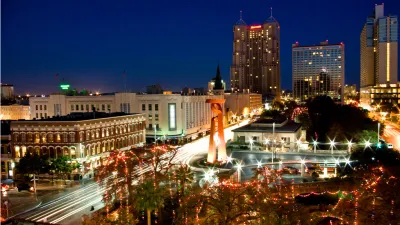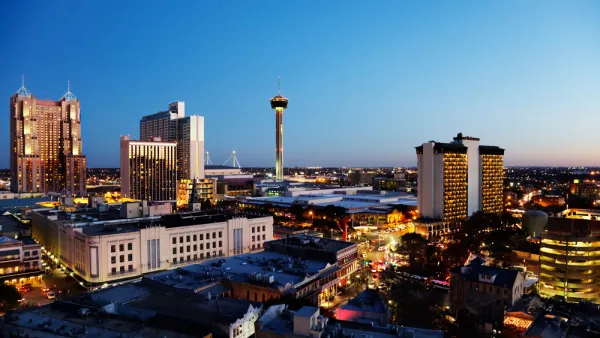The city may grow by 200,000 in the next two years, surpassing Philadelphia and Phoenix, if city leaders agree to annex five surrounding unincorporated areas. The Wall Street Journal considers the effect of annexation on meeting inner city needs.

"San Antonio 'should consider itself lucky,' said Andrew Reschovsky, an annexation expert with the Lincoln Institute of Land Policy in Cambridge, Mass," writes Austin-based reporter Nathan Koppel for The Wall Street Journal. "He said many big cities have been weakened by losing affluent residents—and their taxes—to suburbs, and noted that annexation can be a potent tool for cities to effectively retain some of that population."
San Antonio’s Department of Planning and Community Development has recommended annexing five areas, which total 66 square miles and are located to the north, east and west of the city limits. Most of the areas are in Bexar County.
"A majority of San Antonio’s 10-member city council is expected to vote in favor of annexing some or all of the targeted land," writes Koppel. One exception will be Shirley Gonzales, who believes "San Antonio should focus instead on providing better services to inner-city neighborhoods like the ones she represents."
However, "Stephen Klineberg, an urban planning expert at Rice University, said many city planners view annexation as a means to advance their inner-city goals," adds Koppel.
“When rich people go out into the suburbs that is where the money is,” he said. “You can use that tax revenue to develop the urban core.”
Of course, that's a reason why outlying, unincorporated residents resist annexation.
“No one ever wants to pay more taxes,” said Mamerto Luzarraga, a 47-year-old real estate professional who lives in Alamo Ranch, a large community that could be swallowed up by the city. “One of the selling points of this community is that you live close to city amenities, but you get to pay reduced taxes.”
If the votes goes as expected in 2015 and 2016 to support annexation, it would be the city's sixth annexation since the 1980s according to maps accompanying the article. San Antonio, with 1.4 million residents, is currently the nation's seventh largest city.
Correspondent's note: Subscriber-only content to The Wall Street Journal article will be available to non-subscribers for up to seven days after Dec. 22.
FULL STORY: San Antonio Weighs Annexation Plan

National Parks Layoffs Will Cause Communities to Lose Billions
Thousands of essential park workers were laid off this week, just before the busy spring break season.

Retro-silient?: America’s First “Eco-burb,” The Woodlands Turns 50
A master-planned community north of Houston offers lessons on green infrastructure and resilient design, but falls short of its founder’s lofty affordability and walkability goals.

Delivering for America Plan Will Downgrade Mail Service in at Least 49.5 Percent of Zip Codes
Republican and Democrat lawmakers criticize the plan for its disproportionate negative impact on rural communities.

Test News Post 1
This is a summary

Test News Headline 46
Test for the image on the front page.

Balancing Bombs and Butterflies: How the National Guard Protects a Rare Species
The National Guard at Fort Indiantown Gap uses GIS technology and land management strategies to balance military training with conservation efforts, ensuring the survival of the rare eastern regal fritillary butterfly.
Urban Design for Planners 1: Software Tools
This six-course series explores essential urban design concepts using open source software and equips planners with the tools they need to participate fully in the urban design process.
Planning for Universal Design
Learn the tools for implementing Universal Design in planning regulations.
EMC Planning Group, Inc.
Planetizen
Planetizen
Mpact (formerly Rail~Volution)
Great Falls Development Authority, Inc.
HUDs Office of Policy Development and Research
NYU Wagner Graduate School of Public Service





























